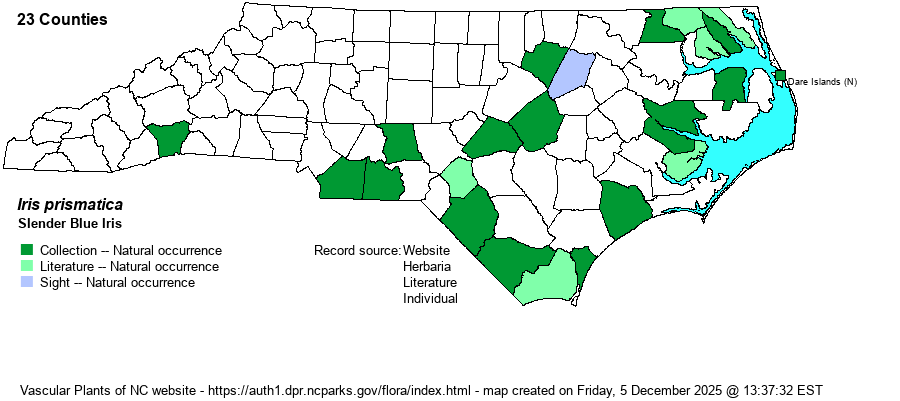| Author | Pursh | |
| Distribution | Widely scattered across the Coastal Plain and eastern Piedmont edge, west to Franklin, Montgomery, and Anson counties. Recorded from one county in the southern Mountains. No records for the majority of the Coastal Plain counties, nor from the Sandhills proper. A specimen from Columbus County (Waccamaw River Swamp) proves to be I. tridentata.
This is basically an Atlantic coast species, barely ranging west to states not bordering the ocean. It ranges from NS and ME on the north to GA and AL on the south, though TN does have a few records. | |
| Abundance | Rare, and mainly found in the northeastern Coastal Plain (north of Albemarle Sound) and in a narrow band near the Fall Line from Franklin and Nash counties to SC border counties. Very rare over most of the Coastal Plain and eastern Piedmont, and casual (if still present) in the Mountains. As there are many specimens for this species, covering 13 counties, plus additional records that bring the number of counties reported to about 20, implies that the NC NHP's State Rank of S1S2 is too conservative, and this website recommends S2. It is a State Significantly Rare species. | |
| Habitat | This is an iris of wet or seasonally wet ground, usually where sunny. It grows in ditches, fresh marshes, wet spots in powerline clearings, and various types of boggy ground. In Montgomery County it has been found growing in wet, seepy, clayey, streamhead ecotones of the Uwharrie Mountains. As the species has such a fragmented and sparse distribution in the state, but yet a fairly broad range of common wet habitats, the species obviously has specific habitat requirements that cause it to be absent from most of these habitats. | |
| Phenology | Blooms in May and June, and fruits in June and July. | |
| Identification | This is one of the four tall native Iris species in the state. This is the only one that has very narrow and practically grass-like leaves, they being 1-1.5 feet long but barely 1/4-inch wide. The flowering stem reaches 1-1.5 feet tall, roughly near the tips of the leaves. The mostly violet-blue (usually more blue in color than violet) flower averages 3 inches across; several flowers can occur on a single stem, though they normally appear in bloom one at a time. As with all Iris flowers, each petal and sepal has some white color near the bases; in irises, the petals are shorter and more erect than the spreading sepals. The sepals tend to look more slender and spreading outward than found on the much more common and familiar Iris virginica, giving the flower and whole plant a "skinny" look, helped out by the very narrow leaves. It is still possible to stumble onto a new population of this scarce species in the state, such as in a roadside ditch or a wet spot in a powerline clearing well off a road. The reasons for its "wide" range in NC yet its scarcity across it is baffling. Thankfully, it can occur in dense and sizable colonies, and of course when a colony is in bloom it is quite a spectacle.
| |
| Taxonomic Comments | None
| |
| Other Common Name(s) | Slender Blue Flag, Cubeseed Iris. Note that the tall species of Iris tend to also be called as "Blue Flag". | |
| State Rank | S1S2 [S2] | |
| Global Rank | G4G5 | |
| State Status | SR-T | |
| US Status | | |
| USACE-agcp | OBL link |
| USACE-emp | OBL link |

